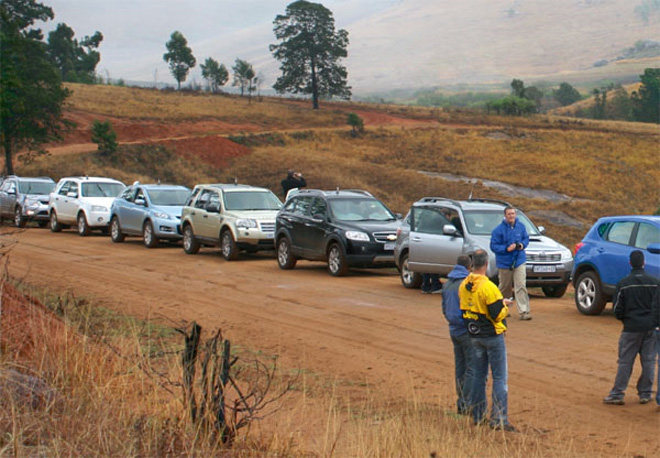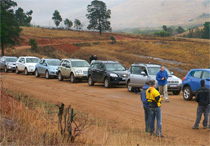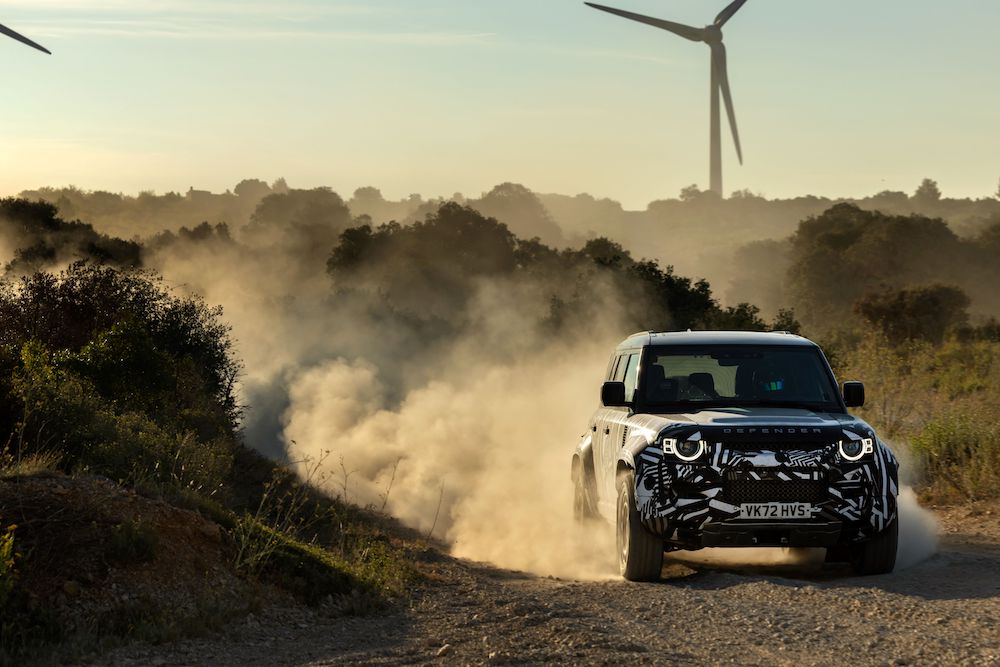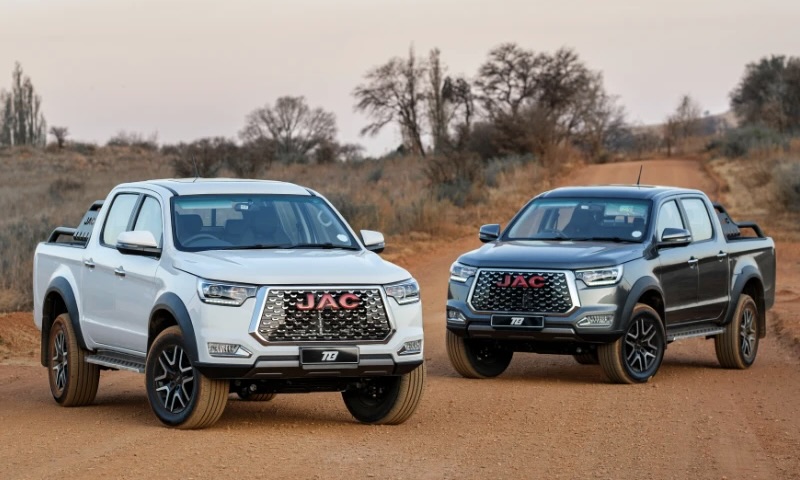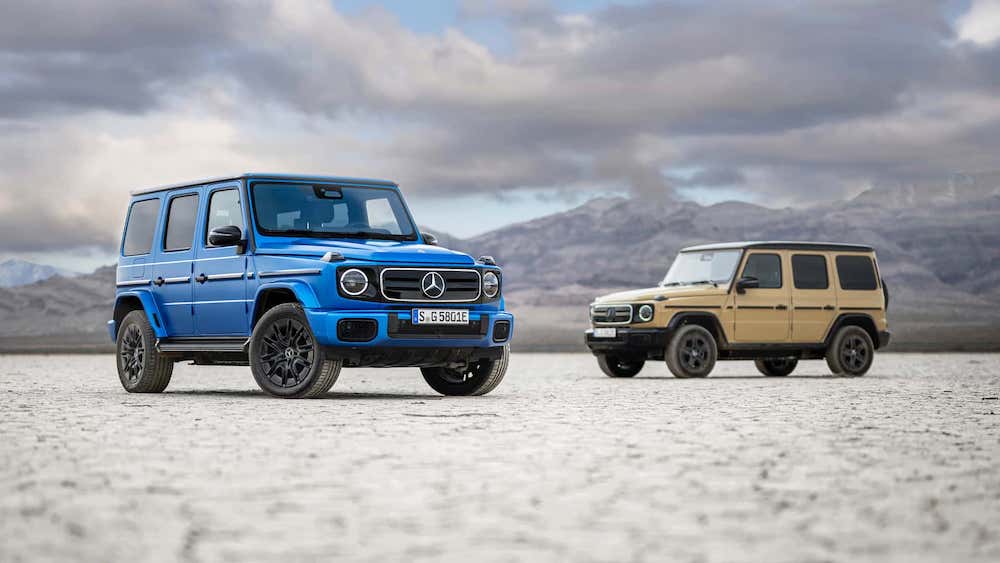Okay, “battle” may be a strong word for what was really just a fun adventure trip for “softer” sport-utility vehicles – those you would normally not find bashing bundus. But the route – and the weather – had some plans of their own…
Text: Johann van Loggerenberg Photographs: Jannie Herbst
In the northwest corner of the country, and with Mbabane as its capital, lies the Hhohho region of the Kingdom of Swaziland. It’s an area with high mountain peaks and deep valleys, crisscrossed by rivers, streams and canyons etched out by millennia of erosion.
The mighty Drakensberg range runs along the western border before swinging left to the Blyde River canyon and continuing to the Soutpansberg. In the west, near the Oshoek border post, is the Ngwenya Mountain, so called in the local language, siSwati , because it is said to resemble a crocodile. At 1829m it’s Swaziland’s second-highest peak and home to what is believed to be the oldest mine in the world.
The east is also home to the Malolotja Nature Reserve, where the rare blue swallow can be found, the Hwane Dam and the Hawane Resort. To the east, the country slopes down to about 800m in the direction of Giba and the Mkhomati River, a tributary of the Komati .
Our story starts at the Hawane resort, for it is here that we’ve asked representatives from 14 South African motor companies to meet, each arriving in a compact sport-utility vehicle from their company’s stable. Two more SUVs were to be driven by Leisure Wheels staffrs.
The only glaring omission was Volkswagen, which chose not to send its Tiguan. But the rest was pretty representative of what is referred to as “soft -roaders”, or crossover vehicles available on the South African market.
In alphabetical order, we had the Chevrolet Captiva 2.0 VDCi LTZ diesel, crewed by GMSA’s product brand manager, Ryan Visagie, and his wife, Jenny. Daihatsu SA general manager Jaco Oosthuizen was joined by sales manager Johnny dos Santos in the slightly modified Off -Road version of the cheeky little Daihatsu Terios, while Hyundai’s advertising and PR manager, Jaco van Loggerenberg, chose the 2.2 CRDi diesel automatic version of the Santa Fe.
James Segal, brand manager at Ford, and Colette Lee, brought along the four-litre V6-powered Territory Ghia.
Chrysler Jeep’s public relations manager, Richard Sloman, arrived in a Jeep Cherokee 2.8 CRD Limited – one of three of the 16 vehicles that boasted low range. He was accompanied by his 15-year-old daughter, Robyn.
Kevin Wise, national technical manager at Kia Motors SA, and his wife, Helen, brought along a Kia Sportage 2.7 V6.
Another of the petrol-motivated vehicles on the trip was the turbocharged Mazda CX-7 2.3 in the hands of Mazda’s public affairs technical representative, Johan Theron, and his wife, Malene.
Mitsubishi Motors SA’s media specialist, Edward Makwana, had the Mitsubishi Outlander 2.4 GLS automatic as his steed – also petrol-driven.
Two Nissans were represented. The first was the six-speed XTrail 2.0D LE crewed by X-Trail and Murano product manager Ross Garvie and Dominique Simonsen, while Qashqai and Livina product manager Nathalie Lopez-Ruiz had the opportunity to put the newly launched 4WD turbodiesel version of the Qashqai through its paces. She was joined in the vehicle by Paul Gurney.
Veterans of quite a few Leisure Wheels trips, SsangYong marketing manager Pedro Pereira and wife-to-be Sherene Cotchobos, made an appearance in the Actyon 2.0 CRD, while another familiar face was that of Grant Bowring, Subaru SA’s brand and marketing manager, in a new turbocharged Forester 2.5 XT Premium.
André Venter, divisional manager sales and marketing at Suzuki Auto SA, and his son, Charles, had the Grand Vitara 3.2 V6 – along with the Jeep and Actyon the only other vehicle with low range. And from Toyota SA came senior media relations officer Sharon Garson, accompanied by Derick Irving in a RAV4 2.0 VX – the vehicle that originally started the compact SUV trend.
Neil Piper – recently promoted to publisher of Ramsay, Son and Parker (RS&P) Automotive, the division responsible for the company’s motoring titles – and marketing manager Dean Dicks were roped in to drive the Land Rover Freelander 2 TD4 HSE.
The remaining vehicle – the diesel-powered Honda CR-V 2.2 CTDi – was driven by Leisure Wheels editor Johann van Loggerenberg, accompanied by better-half Retha.
The tour leader was the well-known 4×4 personality, Francois Rossouw, while Swazi local Andy Cory was to be our guide.
At the Friday breakfast briefing, Francois made it clear that this wasn’t to be a shoot-out to find the best vehicle. It was rather an opportunity for company representatives to drive their vehicles in challenging conditions and, yes, to offer them the rare opportunity of finding out how their vehicles compared with those of the opposition. Some would even swap vehicles – another rare treat.
The original route laid out by Andy, a businessman and sometime 4×4 instructor who knows all the little back roads in the country, was intended to be perfect for softer SUVs without low range, but the weather gods had other plans.
A cold front swept in, bringing with it icy conditions, rain and dense fog, and necessitated a last-minute route change to lower parts of the country, below the cloud layer. The roads were wet, and streams started flowing more strongly. Plan B was going to be a bigger challenge than the original…
From the Hawane Resort the convoy turned left onto the MR1 tar road north to Pigg’s Peak (named after gold prospector and miner William Pigg, who found a sizable quartz reef on the mountain), and after a kilometre turned right onto a sand (or rather muddy) road.
Scarcely another kilometre farther on, still on the way to the “4×4” sections, the trouble started. The combination of a slippery clay surface, an incline and a wrongly cambered bend saw the first couple of vehicles slip-sliding away, and the danger of ending up stuck in the bushes at the side of the road became a real one.
Andy decided that the last couple of cars should turn around and take an alternative route to meet up with the rest of the convoy. Jaco Oosthuizen didn’t hear the instruction, but the little Terios made it through, albeit with engine screaming.
Reunited, the convoy continued while Francois explained via the two-way radios why Handbrake Hill, our next obstacle, is so named. “It’s so slippery and steep that when you go down you should use the handbrake as well as the pedal to help slow the vehicle. Don’t just rely on the foot brake. And don’t lock up the brakes, otherwise you’ll start sliding.”
Here and there a knuckle turned white…
To make it worse, two deep dongas formed by erosion had to be crossed on the way down. At the first, erosion had exposed a rocky crevice that had to be crossed at just the right angle to prevent damage to the underbody. The surface was firm, though.
“Don’t watch the road. Just watch my hands,” said Francois. A little left; sharp right; slowly; straighten up; keep coming; very slow. The sign for very slow is quite similar to that used to show you’re scared, or “nipping”. Quite apt.
Then a thumbs up. You’re through.
At the next donga a slippery surface and negative camber complicated matters. Another hand sign joined the repertoire. Pull up the handbrake, Francois signalled. The vehicle straightened up, and cleared the obstacle.
“When you use the foot brake on such a slippery surface, the front wheel locks and you lose the steering. So instead of turning, the car continues straight on. When braking the rear wheels with the handbrake, steering is retained,” Francois explained.
The convoy got moving again, the road now more level and less slippery. Patches of mist, and light rain. More water crossings, then a deep one with a steep exit to the right. The drivers just needed to get the angle right, and made it through without mishap.
Then the leading Patrol turned off the main road. “Shall we follow you, Francois?” asked SsangYong’s Pedro. “Yes, come.”
The tracks snaked up the mountain to two large boulders standing side by side. A white marquee appeared in the mist. Inside were tables laden with finger food. It’s lunch. It’s raining outside. Just as well Hawane Lodge, which did the catering, also had a plan B…
The original lunch stop was planned to be on another hilltop, with magnificent views across Swaziland. But with the fog limiting visibility to about 15m, it would have been a futile exercise.
After lunch we carried on towards the viewpoint anyway. Maybe we’d be lucky and there would be a break in the clouds.
But first, another nasty water crossing – steep in, and even steeper out. A protruding rock lodged tightly right in the middle of the road, just where the rear wheels dipped into the water, making it impossible to use momentum – unless you wanted to lose the rear bumper.
The steep exit necessitated the placement of two rocks to drive onto with the front wheels, to lift the front of the vehicle out of harm’s way. Again it was a question of watching Francois’s directions.
After the vehicle cleared the stream it stood at an acute angle, facing uphill. Only now could the driver “put foot”.
Of course, the surface deteriorated as one vehicle after another grappled for grip, with the spinning wheels digging the holes deeper and deeper into the exit line.
By the time the Outlander arrived, the surface had deteriorated to such an extent that it left the right front and left rear wheels in the air, halfway up the obstacle. An automatic gearbox prevents building up engine revs for a quick start out of the blocks. After a few attempts, the Toyota Prado support vehicle was called to pull the Outlander out.
The driver of the Grand Vitara decided on momentum into and out of the obstacle, the underside banging on the rocks, while the automatic Santa Fe, second-last and 17th on the road, could not get the revs up either for the attack. The driver asked for a tow rather than risk damage to the vehicle.
The sweep vehicle, the Honda CR-V, had the advantage of a manual gearbox and almost instantaneous transfer of power to the rear wheels when the front ones started to spin. With a liberal amount of power applied, it literally leapt out on the other side.
The road now went through a small wattle plantation up a rather innocuous-looking hill. But soon the reports came in over the radio: “The Captiva is going back for a second attempt. Just hold back – the Terios has to reverse.” And so on down the line.
Problem was that the very narrow road was even wetter and more slippery among the trees, exacerbated by a very rough surface that threw the vehicle off line, necessitating the lifting of the right foot.
But soon afterwards, everyone arrived at the lookout point, shrouded by fog. The sun didn’t have a chance.
From here it was downhill – literally – to Hawane and the end of our 90km off -road route. Dinner, and the chance to swap tales about the day’s adventure, awaited.
As Murphy would have it, Saturday dawned bright and sunny with not a cloud in the sky. Jackets and jerseys made way for short-sleeved shirts and shorts. It would have been nice to go back to that lookout point today, but the itinerary dictated otherwise.
It was a day for shopping, lunch and a show at the Mantenga Cultural Village, and a cocktail at the Royal Swazi Spa hotel in the Ezulwini Valley.
Swaziland is a paradise for people looking for arts and craft s a little out of the ordinary, with places like the famous Ngwenya glass factory, Swazi Candles, the Swazi Market and House on Fire.
If you’re interested in the history and culture of the friendly Swazi people, the Mantenga cultural tour is a must-do.
The cultural village is a living museum and represents a classical Swazi lifestyle during the 1850s. The building materials are strictly traditional: poles, grass, reeds, leather strips, earth and dried cow-dung.
The Mantenga Village is a mini-complex of 16 huts, each with its own specific purpose, kraals or byres for cattle and goats, reed fences that serve as windbreaks, and various other structures. With the traditional artefacts on display, the village illustrates many facets of the ancient Swazi way of life.
Here our guide gave an insight into the Swazi traditions, most of which are still practised today. These include the lobola system, where the husband-to-be has to give the bride’s parents a dowry of up to 17 head of cattle. Or polygamy – if the man of the house can afford more than one wife.
For the king, it’s obligatory to marry more than one wife. He is “Nkosi Dlamini” and is expected to unify his position by choosing wives from all sectors of the community.
The current ruler, King Mswati III, has 13 wives. His father, King Sobhuzu II, who ruled from 1921 until his death in 1982, had 70 wives and more than 1000 grandchildren.
As with many developing countries, Swaziland presents a mixture of traditional customs and modern practices. But the old ways are retained and result in the traveller being greeted by people who are courteous, friendly and proud to be Swazi.
You often see Swazis dressed in the “mahiya” – the colourful national costume – sometimes complemented by a shield, knobkerrie and, perhaps, spears. So it’s just as well they are a friendly people…
Lunch in the boma at the Mantenga Village was delicious, and was followed by a leisurely drive back to Hawane and a farewell supper in the Malolotja Nature Reserve.
Every crew was obliged to contribute to the impromptu “concert”, and some of the jokes were decidedly risqué – especially the one about the genie and the tequila…
It also brought an end to the Leisure Wheels Swaziland SUV adventure, where everyone was a winner, rewarded with camaraderie, good spirit and a dollop of fun.
